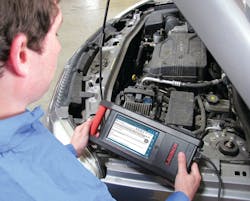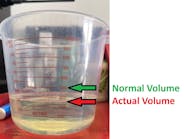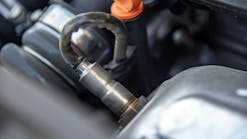Real world EVAP: How to diagnose a P0455 code
CUSTOMER CONCERN:
Code P0455 for a gross leak keeps coming back. The technician replaced the fuel cap and it came back. The technician then smoke tested system and cannot find any leaks.
VEHICLE APPLICATION: 2004 Grand Prix 3.8
AVG. REPORTED MILEAGE: 90,000 miles
Tests/Procedures:
- Apply vacuum to the disconnected tank hose at the evaporative canister.
- Test for fuel cap seal to tank filler neck.
- Test for leak at Fuel Tank Pressure (FTP) sensor.
- Replace FTP sensor as per TSB 04-06-04-025A.
TOOLS USED:
- Scan tool
- Smoke machine
- Flow meter
- Ultraviolet dye solution
- UV light
- Goggles
A customer rolls in with a check engine light. You scan a P0455, an engine code that indicates a large evaporative emissions (EVAP) leak. Your first move: check the gas gap.
So you tighten the cap, delete the code and send the customer on his way. A few days later, the light is back on. Now you know it is not a matter of driver error, but a real EVAP leak that needs to be diagnosed.
If the gas cap has been sealed properly and the code still comes back on, the EVAP system needs to be inspected for points of leaks. This can be due to cracked hoses or parts (like the canister) or an area in the car that has been damaged by rust, such as the fuel filler neck or the gas tank. The challenge is often not in fixing the leaks, but finding them.
P0455 GROSS LEAK DTC
A P0455 leak is a common EVAP code, since any defect in the EVAP system can set it off, aside from internal diaphragm leaks in any EVAP-related solenoids. On a GM, for example, a P0455 can be set by a vent solenoid, fuel tank pressure (FTP) sensor, the charcoal canister, vapor lines, hose connections, filler neck, the fuel tank itself – anything that can cause a leak of more than 20”.
SCAN TOOL TO THE RESCUE
If you are using a traditional scan tool, you have to find all the necessary diagnostic information in an outside database. Depending on what subscription you have, you can search by technical service bulletin (TSB) or by searching the code itself to get the diagnostic procedure from a repair information system. You can then print out any necessary information and take it to the vehicle to do tests.
Some scan tools have all this information built in. Depending on the brand and trouble-shooter program (TPS) software included, a code could lead you to the problem or an area to check for leaks or notify him of component pattern failures.
With online access, the web browser in these newer scan tool gives access to the same repair information systems available on a regular desktop. With this technology, the diagnosis can be accomplished in a matter of minutes: get the code, search the database for a cause and find a solution without leaving the vehicle.
TEST WITH VACUUM PUMP
The P0455 code does not mean a large leak is detected. The code simply indicates the evaporative system is not able to pull the fuel tank pressure down to 0.8 volts. Therefore, since it cannot meet its target vacuum, it considers this a “gross” leak.
Some techs believe that small leaks are easier to diagnose using a vacuuming tool rather than smoke. One method is to block one piece of the system at a time, such as a charcoal canister, fuel tank and sections of EVAP lines, then pull the system to vacuum and check its leak rate.
This approach requires a vacuum pump and a lot of time: blocking each section of the EVAP system, section by section, and creating a vacuum with the pump.
For example, if you suspect the tank hose is faulty, disconnect the tank hose at the evaporative canister and apply a vacuum pump to the tank hose. The purpose is to make sure that anything connected to and including the tank hose does not have a leak. This is accomplished by vacuuming all the air out and seeing if the pump can hold vacuum. If there is a leak, pressure will change.
If the tank hose leaks, the leak will usually be at the fuel pump gasket. The leak can be very small, with no liquid escaping, but big enough for vapor to escape, setting off the EVAP code.
Moisture above the tank can also cause rust at the top, which can be a leak point as well.
WHAT IF THERE'S NO LEAK?
The leaks can easily occur some place that isn’t easy to get to, such as at the fuel pump that was referenced earlier. How can you save time and find the leak without spending all day? The scan tool only indicates a P0455 diagnostic trouble code (DTC), a large leak. But the scanners do not think for us yet. You might not even have a large leak at all, as some OEs set the DTC whenever there is a leak of any size. A restriction in the EVAP system can also trigger this DTC.
If this is the case, the first step is to visually check the fuel cap seal to make sure the fuel cap is fitting correctly. You want to make sure the gasket is in good condition and the filler neck where it meets the cap is not too rusty. If there is any doubt, replace the cap.
A smoke machine with a flow meter is a must for this job. Too many times, when a technician sees a DTC P0455, he puts the smoke into it and starts looking around. But what if there’s no smoke to be found?
This is where the flow meter comes in. You want to make sure there is a leak before you go looking for one. A large leak will show up very easily with a smoke machine flow meter. This should take less than two minutes once you have sealed the system by closing the vent solenoid with your scan tool or PowerProbe. If the system is good, the ball should steadily descend to the bottom of the flow meter to 0,020” or even 0.010” and less. If the ball in the flow meter never drops to the bottom and stays in the upper section, you have a leak. As one trainer is fond of saying: “If the ball is floatin’ it’s time to start smokin’!”
Most of the time, the smoke will lead you right to the location. But sometimes, this location is hard to get to or see, like the top of the tank, or under a shield. Sometimes the fuel level of the tank can prevent a leak from being seen. What approach should be taken if the smoke can’t been seen?
THE UV DYE APPROACH
Any machine designed to work with UV dye and the appropriate UV light and goggles will help you find the dye spot that’s left behind like a fingerprint to show you the exact location of the leak. Be sure the UV dye is OEM approved or the dye might corrode the diaphragms in the EVAP solenoids, creating future leaks.
To be quick, accurate and avoid comebacks, you should run the smoke for the full 5-minute cycle if the source of the smoke is hidden and requires disassembly. Why? Like all UV dye, it takes time to deposit. Smoking a “hidden” leak for less than five minutes usually isn’t a shortcut; it can actually make finding some leaks impossible.
Make sure your UV light matches the UV dye. Not all UV lights are the same. To test it, pull the dipstick out of your smoke machine and shine your UV light on it. If you have two or three different lights, try them all to see what works best. The right UV light can make all the difference. Lastly, look at likely spots and connections. If necessary, remove parts that might be in your way from observing critical EVAP components that might be leaking.
USE AN EMISSIONS ANALYZER
An emissions analyzer can be used to check for everything from a leaking gas cap to a corroding FTP. The analyzer will indicate an increase in hydrocarbons (HC) if there is a fuel or fuel vapor leak.
Fuel vapor leaks are pure airborne HC. To use the emission analyzer to check for leaks, place the car on a lift in a closed bay, without any fans. Take the probe and work from one end of the car to the other, following EVAP lines and components from end to end. Be sure to move the probe slowly to allow time for the machine to update and give an accurate HC count.
Don’t forget to get the probe above the gas tank to check spots you cannot see, and work your way into areas where the EVAP canister is. Where there is a vapor leak, there will be a spike in HC (from zero into the hundreds).
To simulate what kind of numbers you would see, just loosen the gas cap, wait a minute and run the probe near the gas cap until the numbers spike. This will indicate how close you need your probe and what kind of HC count you should expect.
Try to test around critical leak points, depending on the manufacturer of the vehicle. On GMs, this might be the vent solenoid or the FTP sensor. Sniff around the sensor for vapor leaks or an increase in HC. One word of caution: don’t immerse the analyzer probe in liquid fuel. If you do, it will break.
There are different ways to diagnose an EVAP problem, particularly a P0455. A shop on a budget can use just a vacuum pump and a generic OBD II scan tool. The high end diagnostician can whip out the emissions analyzer. Everyone in between can use their smoke machine and dye for a very hairy situation. With the right tools and techniques, you can tackle any EVAP problem.
STEPS
Tests/Procedures:
1. Apply vacuum to the disconnected tank hose at the evaporative canister.
2. Test for fuel cap seal to tank filler neck.
3. Test for leak at Fuel Tank Pressure (FTP) sensor.
4. Replace FTP sensor as per TSB 04-06-04-025A.
|
VEHICLE APPLICATION:
AVG. REPORTED MILEAGE:
|


